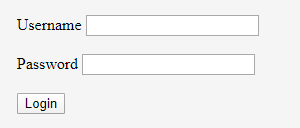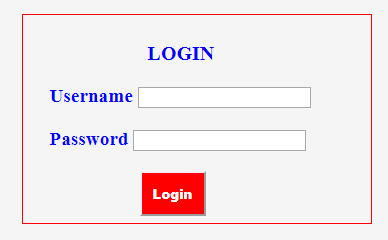PHP 登录模板
在本文中,我们将学习 PHP 登录模板。当我们谈论 Web 应用程序时,我们需要一个登录页面来访问它。这是拥有登录页面的基本要求之一。登录页面是任何 Web 应用程序中访问受限的必需页面之一。大多数登录页面仅包含两个字段。通常,用户名被视为第一个字段,第二个字段被视为密码字段。对于登录页面模板没有固定的看法。我们可以根据我们的业务需求使用任何登录页面模板。
广告 该类别中的热门课程 PHP 开发人员 - 专业化 | 8 门课程系列 | 3次模拟测试开始您的免费软件开发课程
网络开发、编程语言、软件测试及其他
语法:
就登录页面的语法而言,在设计登录页面时没有可遵循的经验法则。在本文中,我们将看到一些登录模板的示例。如果我们要求 5 个人想出一个登录页面模板或设计,他们可能会想出 5 个不同的模板,因为就其外观和感觉而言,没有行业标准。因此,在接下来的部分中,我们将看到登录页面模板的渐进式视图以及如何创建此页面。
它是如何工作的?
仅使用 PHP 无法实现 PHP 中的任何登录页面。 PHP登录的模板结合了JavaScript、HTML、CSS、MySql数据库等多种技术。现在,让我们一一看看每个实体的作用。
HTML: HTML 是应用程序任何网页的基本构建块之一。登录页面所需的内容将仅在此 HTML 中编写。
代码:
<!DOCTYPE html> <html> <head> <title>Page Title</title> </head> <body style="margin-left: 20%; margin: 5%;"> <form method="post" action="" name="login_form"> <div class="form-element"> <label>Username</label> <input type="text" name="username" id="username" required /> </div> <br> <div class="form-element"> <label>Password</label> <input type="password" name="password" id="password" required /> </div> <br> <button type="submit" name="Login" value="Login">Login</button> </form> </body> </html>
输出:

我们可以看到,这个页面的外观和 UI 不够专业,我们无法继续。
- CSS:CSS 再次成为 Web 应用程序中最基本的需求。我们可以使用这个CSS来美化我们的登录页面。 CSS 中提供了各种可用选项,可用于使上述登录页面具有专业外观。我们可以使用表单的背景颜色。我们可以使用表单的边框和各种其他相关的东西。
- JavaScript/jQuery:JavaScript 是我们可以用于客户端验证的脚本之一。我们可以根据业务需求使用 JavaScript 来显示错误消息。例如,如果任何字段(用户名或密码或两者)未填写,我们可以停止表单提交。如果我们在登录页面编码时使用 JavaScript 或 jQuery,这又是一个增值。
以上提到的所有内容对于设计登录页面来说已经足够了。但如果我们想处理完整的登录,那么我们还需要 PHP 和数据库(MYSQL 或任何其他)。
实施 PHP 登录模板的示例
现在,是时候查看各种登录页面示例了。我们正在使用上面提到的相同的 HTML 代码。我们将看到使用上述代码或对上述代码进行一些修改的各种模板。
示例#1
代码:
<!DOCTYPE html>
<html>
<head>
<title>Page Title</title>
</head>
<body>
<form method="post" action="" name="login_form" id="login_form">
<div class="form-element">
<label class="head">Login </label>
</div>
<div class="form-element">
<label>Username</label>
<input type="text" name="username" id="username" required />
</div>
<div class="form-element">
<label>Password</label>
<input type="password" name="password" id="password" required />
</div>
<button type="submit" id="Login" name="Login" value="Login">Login</button>
</form>
</body>
<style>
body{margin-left: 30%; margin-top: 5%; max-width: 350px;}
.head {
margin-left: 98px;
font-size: 20px;
font-weight: 900;
text-transform: uppercase;
}
#login_form{
color: blue;
font-size: larger;
border: 1px solid red;
padding: 7px;
}
.form-element{margin: 20px;}
#Login{
font-weight: 900;
background: red;
margin-left: 110px;
padding: 11px;
color: #fff;
}
label{font-weight: 900;}
</style>
</html>输出:

示例#2
在此登录页面模板中,我们将看到与上一个相比更具交互性。我们将使用一些更高级的 CSS。
代码:
<!DOCTYPE html>
<html>
<head>
<title>Login Page</title>
</head>
<body>
<h4>Welcome to the Website!</h4>
<form method="post" action="" name="login_form" id="login_form">
<div class="form-element">
<label class="head">Login </label>
</div>
<div class="form-element">
<label>Username</label>
<input type="text" name="username" id="username" required />
</div>
<div class="form-element">
<label>Password</label>
<input type="password" name="password" id="password" required />
</div>
<button type="submit" id="Login" name="Login" value="Login">Login</button>
</form>
</body>
<style>
body{
margin-left: 30%;
margin-top: 5%;
max-width: 350px;
background: #c0c078;
}
.head {
margin-left: 98px;
font-size: 20px;
font-weight: 900;
text-transform: uppercase;
}
#login_form{
font-size: larger;
border: 1px dotted #3406ed;
padding: 10px;
}
.form-element{margin: 20px;}
#Login{
font-weight: 900;
margin-left: 132px;
padding: 7px;
color: red;
}
label{font-weight: 900;}
h4{text-align: center; text-decoration: underline;}
</style>
</html>输出:

示例#3
在这个例子中,我们将看到与上面两个登录页面布局不同的。
代码:
<!DOCTYPE html>
<html>
<head>
<title>Login Page</title>
</head>
<body>
<form method="post" action="" name="login_form" id="login_form">
<div class="form-element">
<h2>Welcome </h2>
<input type="text" name="username" id="username" placeholder="Username" required />
<input type="password" name="password" id="password" placeholder="Password" required />
<input type="submit" id="submit" value="Let me in" />
</div>
</form>
</body>
<style>
html{
width: 100%;
height: 100%;
overflow: hidden;
}
body {
width: 100%;
height:100%;
background: #465151;
}
h2{
color: #fff;
text-shadow: 0 0 10px rgba(0,0,0,0.3);
letter-spacing: 1px;
text-align: center;
}
input {
width: 100%;
line-height: 4;
margin-bottom: 10px;
background: rgba(0,0,0,0.3);
border: none;
outline: none;
font-size: 13px;
color: #fff;
text-shadow: 1px 1px 1px rgba(0,0,0,0.3);
border: 1px solid rgba(0,0,0,0.3);
border-radius: 4px;
box-shadow: inset 0 -5px 45px rgba(100,100,100,0.2), 0 1px 1px rgba(255,255,255,0.2);
-webkit-transition: box-shadow .5s ease;
-moz-transition: box-shadow .5s ease;
-o-transition: box-shadow .5s ease;
-ms-transition: box-shadow .5s ease;
transition: box-shadow .5s ease;
}
#submit{
background-color: #4a77d4;
padding: 25px 14px;
font-size: 15px;
line-height: normal
}
form#login_form {
width: 30%;
margin-left: 30%;
margin-top:100px;
}
::placeholder {
color:#fff;
font-size: 18px;
padding-left: 20px;
}
</style>
</html>输出:

结论
PHP登录页面是这个数字革命时代必需的东西之一。由于制作登录页面模板没有任何标准,因此我们可以根据我们的业务需求提前使用任何模板。在向服务器发布任何登录页面请求之前,始终建议使用客户端验证。
以上是PHP 登录模板的详细内容。更多信息请关注PHP中文网其他相关文章!

热AI工具

Undresser.AI Undress
人工智能驱动的应用程序,用于创建逼真的裸体照片

AI Clothes Remover
用于从照片中去除衣服的在线人工智能工具。

Undress AI Tool
免费脱衣服图片

Clothoff.io
AI脱衣机

Video Face Swap
使用我们完全免费的人工智能换脸工具轻松在任何视频中换脸!

热门文章

热工具

记事本++7.3.1
好用且免费的代码编辑器

SublimeText3汉化版
中文版,非常好用

禅工作室 13.0.1
功能强大的PHP集成开发环境

Dreamweaver CS6
视觉化网页开发工具

SublimeText3 Mac版
神级代码编辑软件(SublimeText3)
 PHP与Python:了解差异
Apr 11, 2025 am 12:15 AM
PHP与Python:了解差异
Apr 11, 2025 am 12:15 AM
PHP和Python各有优势,选择应基于项目需求。1.PHP适合web开发,语法简单,执行效率高。2.Python适用于数据科学和机器学习,语法简洁,库丰富。
 PHP:网络开发的关键语言
Apr 13, 2025 am 12:08 AM
PHP:网络开发的关键语言
Apr 13, 2025 am 12:08 AM
PHP是一种广泛应用于服务器端的脚本语言,特别适合web开发。1.PHP可以嵌入HTML,处理HTTP请求和响应,支持多种数据库。2.PHP用于生成动态网页内容,处理表单数据,访问数据库等,具有强大的社区支持和开源资源。3.PHP是解释型语言,执行过程包括词法分析、语法分析、编译和执行。4.PHP可以与MySQL结合用于用户注册系统等高级应用。5.调试PHP时,可使用error_reporting()和var_dump()等函数。6.优化PHP代码可通过缓存机制、优化数据库查询和使用内置函数。7
 PHP和Python:比较两种流行的编程语言
Apr 14, 2025 am 12:13 AM
PHP和Python:比较两种流行的编程语言
Apr 14, 2025 am 12:13 AM
PHP和Python各有优势,选择依据项目需求。1.PHP适合web开发,尤其快速开发和维护网站。2.Python适用于数据科学、机器学习和人工智能,语法简洁,适合初学者。
 PHP行动:现实世界中的示例和应用程序
Apr 14, 2025 am 12:19 AM
PHP行动:现实世界中的示例和应用程序
Apr 14, 2025 am 12:19 AM
PHP在电子商务、内容管理系统和API开发中广泛应用。1)电子商务:用于购物车功能和支付处理。2)内容管理系统:用于动态内容生成和用户管理。3)API开发:用于RESTfulAPI开发和API安全性。通过性能优化和最佳实践,PHP应用的效率和可维护性得以提升。
 PHP的持久相关性:它还活着吗?
Apr 14, 2025 am 12:12 AM
PHP的持久相关性:它还活着吗?
Apr 14, 2025 am 12:12 AM
PHP仍然具有活力,其在现代编程领域中依然占据重要地位。1)PHP的简单易学和强大社区支持使其在Web开发中广泛应用;2)其灵活性和稳定性使其在处理Web表单、数据库操作和文件处理等方面表现出色;3)PHP不断进化和优化,适用于初学者和经验丰富的开发者。
 PHP和Python:解释了不同的范例
Apr 18, 2025 am 12:26 AM
PHP和Python:解释了不同的范例
Apr 18, 2025 am 12:26 AM
PHP主要是过程式编程,但也支持面向对象编程(OOP);Python支持多种范式,包括OOP、函数式和过程式编程。PHP适合web开发,Python适用于多种应用,如数据分析和机器学习。
 PHP与其他语言:比较
Apr 13, 2025 am 12:19 AM
PHP与其他语言:比较
Apr 13, 2025 am 12:19 AM
PHP适合web开发,特别是在快速开发和处理动态内容方面表现出色,但不擅长数据科学和企业级应用。与Python相比,PHP在web开发中更具优势,但在数据科学领域不如Python;与Java相比,PHP在企业级应用中表现较差,但在web开发中更灵活;与JavaScript相比,PHP在后端开发中更简洁,但在前端开发中不如JavaScript。
 PHP和Python:代码示例和比较
Apr 15, 2025 am 12:07 AM
PHP和Python:代码示例和比较
Apr 15, 2025 am 12:07 AM
PHP和Python各有优劣,选择取决于项目需求和个人偏好。1.PHP适合快速开发和维护大型Web应用。2.Python在数据科学和机器学习领域占据主导地位。






